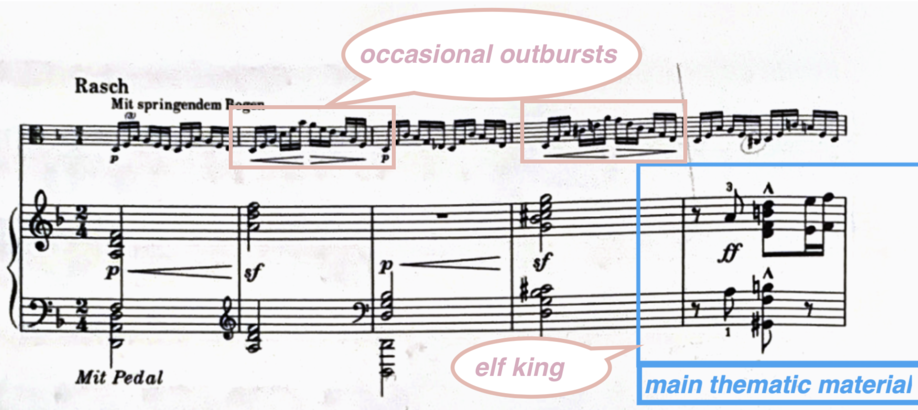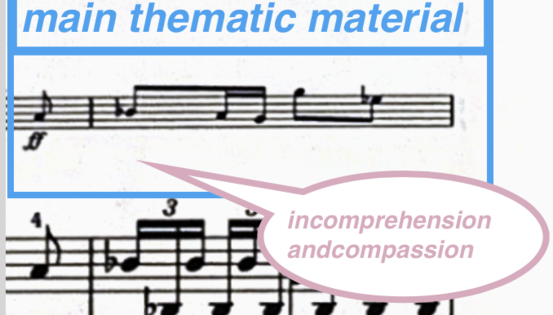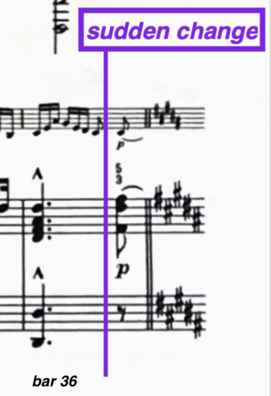III. Rasch
In my opinion, this movement is full of fear and anxiety. The young man is scared to death because he is seeing things that we cannot see. The fast triplets in the viola are the frightened images that his thoughts are imposed with. The hairpins in bar 2 and 4 are the occasional outbursts when the young man feels cornered by the questions that are asked. The main thematic material in the piano reflect the elf king that the boy is afraid of. When the main thematic material is played by the viola in bar 14, the feeling of compassion and incomprehension that the boy evokes are exposed. During the preparation of Märchenbilder, some teachers told me to play with more direction in this part. In the left video below, which I played earlier in the process, I am dragging the notes while in the right video, the notes have more direction and more energy. I think this latter approach, suits the feeling of incomprehension better. So, in this case, the MSE did not necessarily influenced my playing, but it confirmed the idea of how I needed to play this phrase.
The fictional character, Psyche, of this movement is delicate and frail, but also a bit mysterious. Therefore, Marte (my pianist) and I tried to play the beginning intimately while maintaining the projection of sound. Psyche is mainly sad and evokes a feeling of empathy but sometimes there are also moments of happiness. However, the change between euphoric and dysphoric (depressive) states are rationally not understandable. A big challenge within this piece was to make a clear switch between sections within the piece because it felt so unnatural. I was looking for connections between these sections to find a ‘logical’ way of phrasing, because I thought if I didn’t, the listener would not understand. I had to leave my own rational thoughts behind and imagined instead the incoherence of thoughts and feelings. Therefore, my timing became different in such a way that I emphasized the differences in lines. The awareness of sadness and inner struggles meant that I decided not to think in terms of barlines, but rather about phrasing the sentences of the music in ways that go beyond barlines. The awareness of ‘mood-swings’, meant that I realized I had to disconnect certain lines so that the differences in their meaning became more obvious. When I recorded myself on video, as seen on the right, I noticed that my facial expressions were also changing much faster.
In the first fragment below, which I played earlier in the process of studying Märchenbilder, the sentences are more continuous, while in the second fragment below (later in the process), the lines go more ‘up and down’.
In bar 13, my teacher told me to stress the lines to the higher register and to dissapear in the piano when arriving in the lower register. I had to use a faster and lighter bow to create a volatile, airy sound. When I was writing this research paper, I realized that I could have used my imagination of Psyche who wishes to fly on the back of the Chimera.
II. Lebhaft
In this movement, as seen in the video, I could apply energy, and euphoric but also confident feelings of the knight in the main theme. The knight evokes a feeling of amusement and I discovered that while I was playing the piece, I actually did feel a certain joy. The dizzy themes (bar 47 – 50, 115 - 118 and 187-190) are the perseverations of his thoughts. Regarding the ‘ominous character' of the second episode (bar 51 - 66) I imagined that the knight gets agitated but also anxious when he is confronted with questions that implicate that he is not living in the Middle Ages and that he is not a knight. However, due to the increased speed of his thinking he easily drops the subject and goes back to his confident feeling (main theme). For the main theme and first episode of this movement I did not have many difficulties in imagining a suitable character or atmosphere. However, the second episodes (bar 119 – 142) felt very random and my pianist and I had difficulties to find a suitable character. At some point we accepted that this second episode was random as if it was a random thought in a ‘crazy-man's’ head. The ideas of people drinking wine and a big party in a palace also helped us to create a convincing interpretation of this episode. I imagined the raising and toasting with wineglasses when I was playing the half-notes with the accent circumflex. However, they could also be the loud footsteps of the knight.
During my preparation of Märchenbilder, my teacher and I focused on the difference between rhythm patterns through focusing on the timing. In hindsight, I could have connected the different rhythmic patterns with a different emotional load (I thought about this after the recording). For example, the rhythm in bar 4 – 6 is excited, the rhythm in bar 7 – 8 is euphoric and the rhythm in bar 9 – 10 is confident. Also, regarding the knight’s silver colored metal armor, it would be a nice reason to search for a metal sound. This could be achieved with compact bowing and by playing more at the bridge.
The feelings that I associated with specific bars, are added in the score.
Another challenge in this movement was to create a the sudden change in atmospehere for the B-major part (bar 36 to 37). The pitfall was to change our energy too early (in the section before) or too late (after the new section had started). We forced ourselves to make the change right in the middle as if our mind jumped from one thought to another, just as if the character suddenly started to dance a waltz.
IV. Langsam, mit melancholischem Ausdruck
In this movement the incorporation of MSE did not really change something in our interpretation or playing regarding the main theme. The well-groomed old man with a peaceful appearance asked for a warm calm sound. However, for the middle part (bar 31 - 62), the almost childish excitement of the man helped to achieve more flow in this section. Also, when the man is reflecting on his life, it gives a nostalgic feeling in the middle part.
In the video fragments below, I play the middle part (bar 31 - 62). In the left video (earlier in the process), the feeling of inner excitement is not obvious. The direction, energy and sound are less different from the main theme. In the right video (later in the process) I play while thinking about the old man who still feels an inner excitement and energy. I think that the middle part is more flowing in this recording. Especially from bar 39 where the piano starts to play triplets, there is more energy in the way of our playing when thinking about the excitement of the old man.
Regarding the 16th triplets, I expected that the incorporation of the MSE would not really influence my playing, since the triplets are very fast and therefore leave little space for imposing another way of phrasing. However, the opposite turned out to be true. The dynamic differences in the crescendos and decrescendos were bigger when I imagined the occasional outburst. Also, the sound became sharper. In the first fragment below, which I played ‘without the character,’ the dynamics are quite the same, while in the second fragment below, the crescendos are obvious. The only disadvantage was that with these big crescendos I tended to rush in the triplets.


